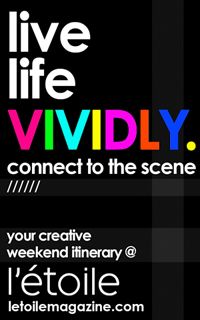With his penchant for vintage silhouettes and bold color blocking, designer Ivan Idland is always one to watch. The Montana native first wowed Voltage crowds in 2008, when he outfitted local dance-punk  quartet Zibra Zibra in fluorescent lycra onesies, each with an outrageous theme unique to its corresponding band member. As a runway designer in 2009, Idland created an expertly-executed, Art Deco-inspired sportswear collection. More recently, Idland and his expert tailoring have tackled Cliché’s Avoid the Grey, RetroRama, and VitaminWaterZero’s Flourish. For this year’s Voltage collection, Idland is mixing the wearable and the avant-garde, and if the sketches he released back in October are coming to life for this line, we can expect to see some sailor collars, bloomers, and youthful, tiered skirts. Either way, we’re more than excited to see what eye-popping wares he’s prepared.
quartet Zibra Zibra in fluorescent lycra onesies, each with an outrageous theme unique to its corresponding band member. As a runway designer in 2009, Idland created an expertly-executed, Art Deco-inspired sportswear collection. More recently, Idland and his expert tailoring have tackled Cliché’s Avoid the Grey, RetroRama, and VitaminWaterZero’s Flourish. For this year’s Voltage collection, Idland is mixing the wearable and the avant-garde, and if the sketches he released back in October are coming to life for this line, we can expect to see some sailor collars, bloomers, and youthful, tiered skirts. Either way, we’re more than excited to see what eye-popping wares he’s prepared.
Ivan talked with us this week about growing up on a ranch, his inspirations, and why designing a garment is like being in a relationship.
l'etoile: You have a background in designing theater costumes, and your designs have oft been lauded for unexpected color combinations, historical references, and asymmetrical patterns. How do you achieve balance between theatrics and wearability? What fashion “risks” are you taking with your Voltage line?
Ivan: Well the theatre thing was a long time ago and doesn't always have a bearing on what I make. It was just more of an introduction for me into the discipline of sewing, as I was a college student and was more on the construction side of things, rather than the design. I really started designing my own clothes after the college experience. At that time my personal style was a bit flashier and bolder (think fringed rhinestone encrusted pants and glitter). I loved it when perfect strangers would approach me out in public and compliment me on my outfit and whatnot, which was a great way to meet people. This is often what I like to capture as I bring a design to fruition. As far as wearability goes, if it fits and someone would wear it, then its wearable. It doesn't have to be for everyone, and I expect and accept that. For Voltage I am mixing a lot of more currently wearable items with others that are more on the showy/avant garde side of things. I want people to be able to envision wearing what's on the runway, as well as put on a show for them.
l’etoile: Before moving to the Twin Cities, you grew up on a ranch in eastern Montana. To what extent has your exodus from rural to urban influenced your design aesthetic?
Ivan: I love bolo ties, silk scarves, and anything with a horse on it. I went to a lot of rodeos as a kid and just remember the flashy outfits that were worn by both the men and the women--crazy yoked western shirts with fringe, huge belt buckles, and such. What you see in the movies was exactly how it was in real life, at least in the 80s and 90s. Maybe that's where my love for color blocking comes from, but then again, that was a long time ago too.
l’etoile: From delineation and conception to construction and completed collection, do you find that your design inspiration is an external process, or something more instinctive? What is your typical method for bringing a concept from inception to a blossomed full collection?
Ivan: I first lay out a basic sketch or general roadmap. Then I cut and drape a pattern using $2 bedsheets that I get at the thrift store. And as I transfer the garment from the pattern to fabric I leave room for any changes that may come up along the way. So I guess in that way it is a combination of external and instinctive. Ill also say this: making a garment can be an awful lot like having a relationship. Each one can have its own personality that affects you in different ways. Sometimes it’s blissful all the way through the process until you say goodbye. Sometimes you question every little step along the way and wonder if what you're doing is the right thing. And sometimes it makes you so frustrated it’s all you can do to keep from tearing it to shreds (which also happens). Sometimes you leave feeling invigorated and accomplished. Sometimes you just shrug your shoulders and say "good enough." But for the most part, if it wasn’t a fun and rewarding process we wouldn't be putting ourselves out there. I'm single, btw. Just sayin!
l’etoile: Now in its seventh year, Voltage: Fashion Amplified has only intensified in popularity and local talent. To what do you attribute Voltage's success and why do you think it continues to gain momentum?
Blending live rock music with a runway show makes it more accessible to a wider range of people. A person who might feel intimidated to go to a regular runway show can feel comfortable and at ease in the "come as you are" first avenue setting. All the hundreds of volunteers are of course the engine that brings it all about, and it would never happen every year if these people who wanted to be a part of it were not there.
l’etoile: What role does music play in your design modus operandi? Are their certain bands or particular songs you put on to cure a design funk?
Not really. I listen to NPR when I sew and sometimes KFAI. I drew a lot of inspiration from my voltage line from current events, especially all the people’s revolutions that have occurred lately.
For more info on Voltage: Fashion Amplified click HERE.









No comments:
Post a Comment